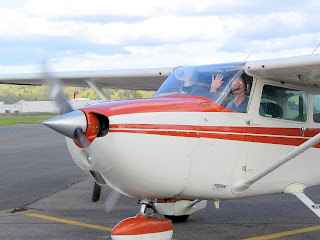Two simple words. But they bring levels of anxiety that are difficult to describe unless you’ve lived through the experience. A student pilot, having met all the requirements of flight, ground school, and the written test begins prep for the big final. Lessons become practice and review, learning what to expect during the checkride. Then the day arrives.
I’d like to say the experience was wonderful. I’d like to say I remember it well. Neither of those statements is even close to the truth. I was a nervous, near-wreck. I’d heard the horror stories of students flunking for seemingly minor imperfections. I flew to Kelso my mind busily reviewing to the point that nearing the airport I had to stop the internal litany with a stern reminder “Fly the Plane!” A note on this phrase. CFI’s teach this to students early on. When things are not going right, or if there should be an emergency, the very first thing a pilot must do is Fly the Plane. This probably seems simply obvious to those who have never found themselves behind a yoke, but believe it or not, any number of distractions from the simple to an emergency can cause a pilot to not be focusing where he should, on flying the plane. So when a student is rattled because of a poor landing and takes off to go around again, neglecting say to raise the flaps, the instructor corrects and admonishes “Fly the Plane!”
Okay. So I’m now flying the plane and manage a beautiful landing at Kelso. The last one of the day, I might add. The rest of the next 3 hours is a blur that went by in minutes and yet lasted forever. Maneuvers I’d been doing excellently and to standards suddenly were beyond my grasp. I practically couldn’t differentiate between up and down. The check ride examiner was a nice guy with no fangs or horns, but I feared his power. He held my future as a pilot in his hands. The one skill I clearly remember demonstrating is the engine out emergency landing.
“You’ve lost your engine.” The examiner stated as he pulled the throttle back to idle. I, pilot in command, calmly setup the plane for best glide, looked around, selected a flat pasture one mile away and began gliding toward it. Asked if I thought this pasture was close enough to make, I assured him that was the case and continued descending, but with newly planted apprehension.
What did he know that I didn’t? It was close enough, I was sure. Wasn’t I? In the end I stuck to my plan and now the plane was only a few hundred feet above the ground, field of tall grass coming closer as we descend still. He’s not going to make me land is he? I might get down, but what about taking off again. Is the field long enough? What the hell! Finally I spoke aloud, voice wavering. “You’re not going to make me land are you?”
To this day, I’m sure he enjoyed an internal chuckle as he allowed me to add power and climb.
At last the flying was over and I taxied to parking knowing that I would not become a pilot this day. In the office he began pulling out paperwork and I stood, mute, mind churning with dreadful thoughts. I’ll have to face the shame, telling Russ, Mike and friends that I had failed. No problem. I’ll practice and schedule another check ride and get it for sure next time. Then his voice pulls me back to the present. “Well, I’m going to give you your pilots license, but I want you to consider this a license to learn how to fly.” Afraid to speak, I stood voiceless as he filled in that precious piece of paper – a temporary license; to be followed by what would be one of my most precious possessions – a plastic card that declared my right to WINGS!
Paper in hand, I thank him, and walk out, head high, proud to share the good news with Mike who is waiting his turn to earn his license. As I drove home, Mike did earn that license so here we were two new pilots on the same day. I love to tease that I am, however, The Senior Pilot in the family.
Thursday, October 23rd 2003 - I am a Pilot!



















